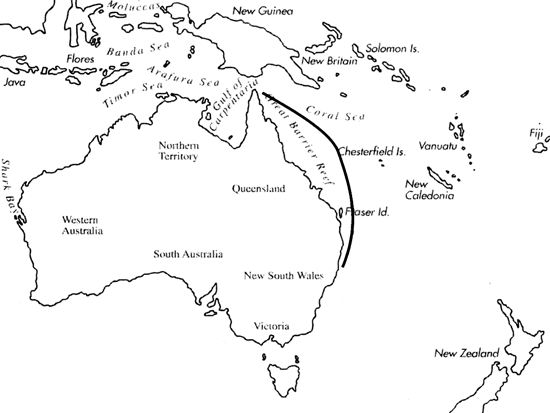Range: Queensland to N. New South Wales, Australia.
Description: Small to moderately small, light to moderately solid. Last whorl conical or ventricosely conical to broadly conical or broadly and ventricosely conical; outline convex adapically, less so below; left side slightly concave near base. Shoulder angulate, sometimes subangulate. Spire usually of moderate height, outline concave to slightly sigmoid. Larval shell of 1.75-2 whorls; maximum diameter 0.7-0.8 mm in typical form, 0.8-1.1 mm in form innotabilis (Pl. 59, Fig. 37). First 3-4 postnuclear whorls smooth to very weakly tuberculate in typical form, weakly to distinctly tuberculate in form innotabilis. Teleoconch sutural ramps flat, with 0-1 increasing to 3-5 spiral grooves. Last whorl with variably spaced, axially striate spiral grooves on basal third to two-thirds and with 2-3 additional grooves just below shoulder; intervening ribbons narrow toward base and at shoulder. In form innotabilis, entire last whorl with strong spiral grooves.
| Shell Morphometry | ||
|---|---|---|
| L | 17-32 mm | |
| RW | 0.04-0.15 g/mm | |
| (L 17-27 mm) | ||
| RD | 0.66-0.74 | |
| PMD | 0.79-0.89 | |
| RSH | 0.15-0.22 | |
| (- form innotabilis 0.12 - 0.26) | ||
Ground colour light bluish-grey in typical form, white to pinkish violet in form innotabilis. In typical form, last whorl without pattern or with orangish brown to brown spots and flecks forming spiral bands below shoulder, above centre and often within basal third. Spiral rows of alternating brown dots and pale grey dashes extend from base to shoulder, varying in number and prominence. Form innotabilis differs in the yellowish brown to orange colour of the pattern. Larval whorls white, sometimes grading to pale olive in typical form. Postnuclear sutural ramps with radial lines to blotches extending beyond outer margins and matching last whorl pattern in colour. In typical form, aperture violet, demarcated from the margin by a brown collabral band; form innotabilis with an orange aperture.
Radular teeth with an adapical barb opposite a weak blade; serration ending in a small cusp above the central waist; base with a spur (Rolán, 1993).
Habitat and Habits: Typical form in shallow water to about 55 m; form innotabilis in 40-150 m.
Discussion: C. cyanostoma cannot be confused with adult specimens of any of its Indo-Pacific congeners. Caribbean species as C. puncticulatus Hwass and C. jaspideus Gmelin may be similar in shape and colour, but differ mainly in the absence of spiral grooves from sutural ramps. The holotype of C. cyanostoma represents the patternless variety of the typical form. The conchological differences between typical form and the deeper subtidal form do not justify a separation at the species level. Erosion allows no data on the apices of the 2 syntypes of C. innotabilis they otherwise match the deeper-subtidal shells of C. cyanostoma. We therefore apply the form name "innotabilis" to these shells. C. coxeni is known only by the original figure showing a shell with a straight-sided high spire (RSH ca. 0.33) and a broad last whorl (RD ca. 0.78), strongly sculptured on its basal two-thirds. The figure does not match typical C. cyanostoma nor form innotabilis satisfactorily. We provisionally assign C. coxeni to C. cyanostoma as a form or an aberrant specimen, although it might represent a separate species (see Coomans et al., 1985a; Richard, 1990).

C. cyanostoma range map
This section contains verbatim reproductions of the accounts of 316 species of Conus from the Indo-Pacific region, from Manual of the Living Conidae, by Röckel, Korn and Kohn (1995). They are reproduced with the kind permission of the present publisher, Conchbooks.
All plates and figures referred to in the text are also in Röckel, Korn & Kohn, 1995. Manual of the Living Conidae Vol. 1: Indo-Pacific Region.
The range maps have been modified so that each species account has it own map, rather than one map that showed the ranges of several species in the original work. This was necessary because each species account is on a separate page on the website and not confined to the order of accounts in the book.